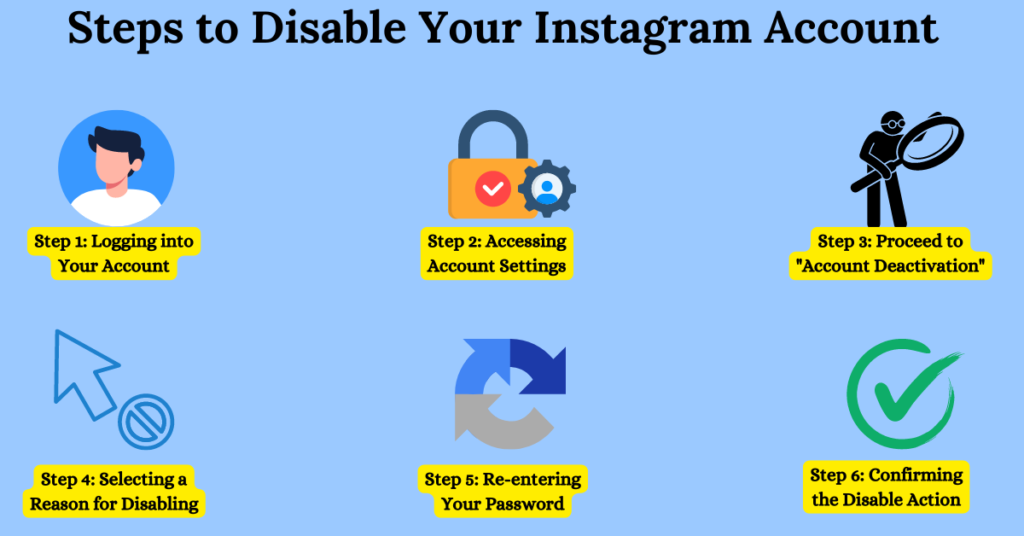How to Disable Your Instagram Account
Instagram has emerged as a must-have in many people’s daily lives. It is where picture uploading, friendship formation and business marketing happen. All centred around your Instagram account. Like every other social media platform, there may come a time when you want to take a break. If you’re wondering how to disable Instagram, whether to seek mental wellness, minimize diversions, or have a digital timeout, this guide will cover everything you need to know. It will describe what deactivating your account entails and then provide a detailed procedure.
Understanding the Difference Between Disabling and Deleting
Before the how-tos, know the difference between disabling and deleting your Instagram account. Deactivating your account is a temporary measure. It allows you to take a break from Instagram without losing your account, followers, or posts. We will hide your profile, photos, comments, and likes. They will stay that way until you reactivate your account.
So, deleting your Instagram account is a permanent action. All your data, including photos, followers, and comments, is gone. No return is possible should you want to return to Instagram; if so, you must start from scratch by opening a new account.
Reasons to Disable Your Instagram Account
People deactivate their Instagram accounts for many valid reasons. Here are some common motivations:
- Taking a Break from Social Media: The posts and alerts can be overwhelming. Shut down your account and turn off your focus from the virtual world to real-life relationships.
- Mental Health Protection: Research says using societal applications worsens mental health. It leads to emotions of inferiority, envy, and anxiety. A short break might be exactly what you need to get your bearings straight.
- Avoiding Distractions: Instagram can distract you. This is a problem when you need to focus on essential tasks, like studying or working. Deactivating your account can help you stay focused.
- Privacy Concerns: As fears about data privacy rise, some users deactivate their accounts to protect their data.
- Temporary Life Changes: Big events, like exams or work projects, may need your full attention. Deactivating your account during these times can help you manage stress.
Read: How to Unarchive Your Instagram Stories: A Step-by-Step Guide
Things to Consider Before Disabling Your Instagram Account
Before you deactivate your Instagram account, consider a few things:
- What Happens to Your Data: Your data isn’t deleted. But you hide everything from the public, including your profile, photos, and comments.
- Impact on Followers and Posts: Disabling your account hides your profile and posts from your followers. However, nothing is deleted. Your account will be restored to its state when you reactivate it.
- Frequency of Disabling: Instagram only allows you to deactivate your account once a week. If you deactivate your account and want to return it, you must wait a week before you can turn it off again.
Steps to Disable Your Instagram Account

Now, let’s get into the nitty-gritty of how to deactivate your Instagram account. Follow these steps:
- Step 1: Logging into Your Account: One way to log into your Instagram account is to use a desktop browser. However, the only way to use this feature is the mobile app.
- Step 2: Accessing Account Settings: Click on your profile image in the upper right junction of the screen. Next, click the “Settings” option from the menu that appears.
- Step 3: Proceed to “Account Deactivation” and select the temporary option. In settings, scroll down the list to find “Deactivate My Account Temporarily.”
- Step 4: Selecting a Reason for Disabling: Instagram will ask why you disable your account. From the dropdown menu, choose the reason that best fits your situation.
- Step 5: Re-entering Your Password: For security, you must re-enter your password before deactivating your account.
- Step 6: Confirming the Disable Action: After re-entering your password, click “Temporarily Disable Account” to confirm. We will deactivate your account immediately.
How to Re-enable Your Instagram Account
Reactivating your account is a no-brainer if you’ve been away and want to return to Instagram. You must sign in with your username and password. Your account will be restored to its original state, including all your content.
Common Issues When Disabling Your Instagram Account
Some users may encounter issues when trying to deactivate their Instagram account. Common problems include:
- Difficulty Accessing the Disable Option: Use a desktop browser. This option isn’t available on mobile.
- Error Messages: If you get an error, try clearing your browser’s cache or using a different browser.
Alternative Methods to Manage Your Instagram Usage
If you’re unsure about deactivating your account but want to use Instagram less, try these options:
- Screen Time Limits: Limit your daily use of Instagram by setting your smartphone’s settings.
- Unfollow Worrisome Accounts: If you are following some accounts causing stress, consider not following them.
- Silence Instagram alerts to avoid interruptions from new notifications.
Read: How to Become a Travel Nurse: Your Step-by-Step Guide
How Disabling Affects Your Instagram Presence
Deactivating your Instagram account hides your profile and content from other users, making it hard for people to locate your profile. We will also hide your comments on others’ posts. But this is all temporary. Once you reactivate your account, you will restore everything.
How Long You Can Keep Your Account Disabled
Instagram doesn’t have a strict limit on how long you can deactivate your account. To avoid delays, check your account often when planning long breaks.
How Disabling Your Account Impacts Connected Services
When you deactivate an Instagram account, its links to Facebook and other services might be affected. You could also risk losing access to all the other apps you’ve used Instagram for should Instagram deactivate your account.
Privacy and Security Considerations

Before deactivating your account, ensure it’s secure. Change your password if necessary and enable two-factor authentication. This is vital if you’re deactivating your account for privacy reasons.
Also Read: How to Sleep Quickly at Night
Revisiting Your Decision to Disable
After some time away, consider considering your decision to deactivate your account. Reflect on why you left in the first place and whether those reasons still hold. It might be worth extending your break if you feel more at peace without Instagram.
Conclusion
Deactivating your Instagram account is easy. It lets you break away from social media without losing your data or connections. If you require a break for personal reasons, learning how to deactivate and reactivate your account is essential. It’s a handy tool for directing your attention to mental health and not getting distracted. It’s crucial to select what’s best for your wellness. Often, it is the most advisable to get away. It contributes to having a healthy relationship with social media.
FAQs
Can you disable your account from the mobile app?
No, you can only do so from a desktop browser.
How long does it take for the disabled action to take effect?
The action takes effect immediately after confirmation.
Will people know I’ve disabled my account?
Others won’t receive a notification, but they won’t be able to locate your profile.
Can I disable my account many times?
Yes, but only once a week.
What if I forget my password while my account is disabled?
You can reset your password through Instagram’s login page.
For Information: Explore, Learn, Grow: A Deep Dive Into Travel Education
